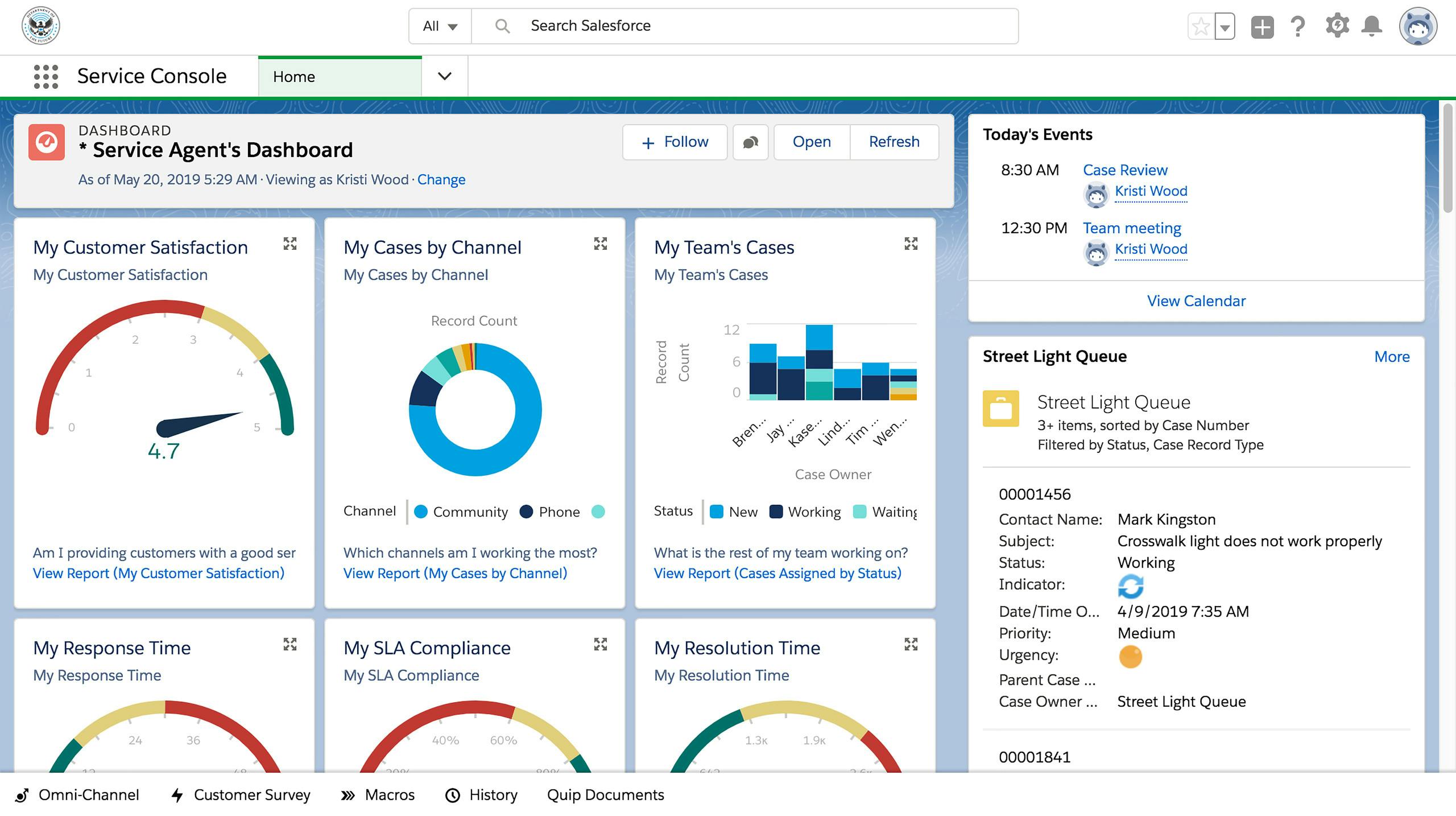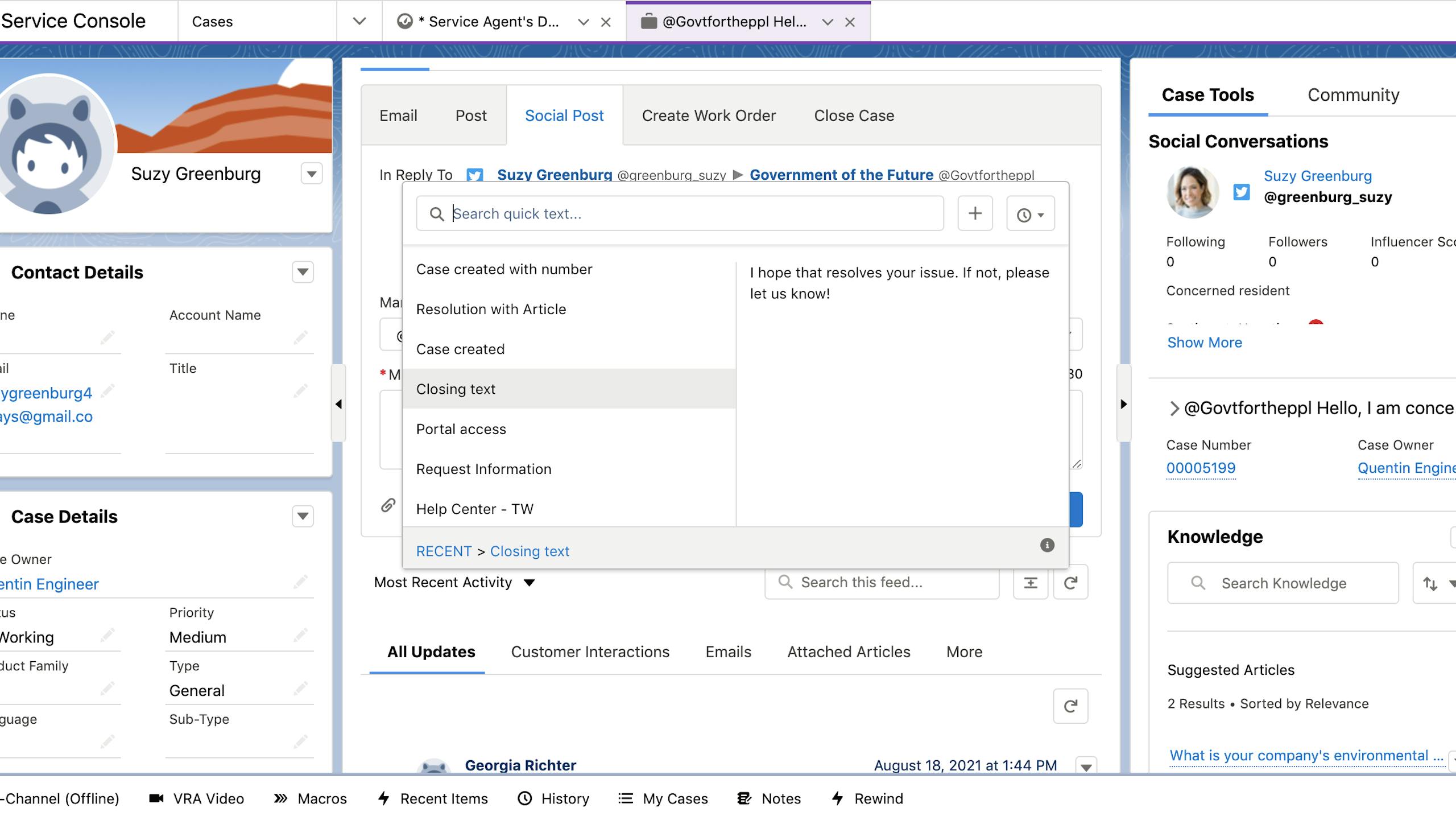1

Dive Deeper
Drive public trust with Tableau by providing transparency on performance. Use consolidated service center data as a source for providing feedback to various department heads, elected officials, and citizens of the community. Interactive experiences allow data segmentation by specific geospatial boundaries to show reported issues by districts, regions, neighborhoods, and other key indicators to all stakeholders.


Improve Citizen Experience
With Salesforce's fully integrated Service console, all citizen communications come together to create a unified, responsive citizen experience. To drive a better service and engagement experience, Salesforce provides no wrong door for citizens to submit and interact with issues needing resolution. Whether you need to set up a full Contact Center, such as a 311 or 988 non-emergency line, or a simple community for citizens to engage with your city, county, municipality, province, region, canton, or state, you are able to give agents a high-level view of how they are performing and show any tasks, requests, or events requiring their attention.


Engage with Ease
Citizens can create and submit reports, request information, apply for basic permits, and access other online government resources from their mobile phones. Salesforce creates a ‘no wrong door’ experience for citizens to bring issues to the attention of the government. In this example, our citizen is submitting a street light outage. The citizen can easily take a picture, upload a photo, and add a location directly from the public-facing web experience.


Provide Visibility
From the service agent’s perspective, they’ve been alerted of the incoming street light outage case that was just submitted from the citizen’s mobile device. Salesforce provides an omnichannel experience for service agents, where agents can opt to manage incoming requests from the web, community, contact center, live chat, or email channels. The agent is able to immediately click Accept.


Add Urgency
Recognizing the location is a busy corridor, the service agent updates the priority to Critical which automatically sets a new target SLA milestone for resolution. The solution provides a single pane of glass for the service agent to see location, details, milestones for each stage in the resolution process and quick tools for making updates.


Get Stakeholder Insight
The agent sends an email from the Service Console to find out when the resident first noticed the outage. Quick actions such as sending templated emails, creating follow-up tasks, booking an appointment, and logging an interaction allow the service agent to capture every touchpoint with the citizen in a comprehensive view.


Access the Community
When citizens are contacted by the service agent, they are notified they are able to join your online Citizen Community. By opting in, they can see a list of all current service requests, add additional details, and message the service agent if follow-up is needed. This allows service agents to take on more complex processes that require back-and-forth communications with citizens to provide better service.


Giving Citizens a Voice
Allow service agents to achieve success from anywhere with powerful embedded voice tools with Service Cloud Voice. Service Cloud Voice provides the leading cloud telephony solutions enhanced with artificial intelligence to modernize your service agent experience with AI voice, voice transcription, and AI-powered recommendations to reduce average handle time, get the citizen to the right person, and improve the service agent experience.


Use Dynamic Templates to Manage Social Media Responses
One of the biggest challenges government agencies face during social media interactions is cultivating a unified front; it can be difficult to train multiple employees to respond with a cohesive voice. And in today’s world, one mis-tweet can have severe consequences. With Salesforce, government agencies can reduce risk by using response templates across multiple social media accounts all within the Service Console, eliminating direct employee access to social media profiles and passwords.
Here we see an example of a templated response, where the case number is automatically populated, so resident Suzy knows her issue has been received.


Use Chatbots to Help Residents Self-Serve
Governments can deploy Einstein Chatbots on their Citizen Community as a call deflection measure to handle some of the most frequent interactions, saving time and agent resources for more complex inquiries, and allowing citizens to self-serve and get the answers they need at any time.


Measure KPIs
Salesforce’s industry-standard reports and dashboards measure key performance indicators, but the potential for analytics does not end there. Service agents and managers can drill into individual reports down to the record level to triage, investigate, provide support, and drive collaboration to resolve a critical citizen issue.

Dive Deeper
Drive public trust with Tableau by providing transparency on performance. Use consolidated service center data as a source for providing feedback to various department heads, elected officials, and citizens of the community. Interactive experiences allow data segmentation by specific geospatial boundaries to show reported issues by districts, regions, neighborhoods, and other key indicators to all stakeholders.


Improve Citizen Experience
With Salesforce's fully integrated Service console, all citizen communications come together to create a unified, responsive citizen experience. To drive a better service and engagement experience, Salesforce provides no wrong door for citizens to submit and interact with issues needing resolution. Whether you need to set up a full Contact Center, such as a 311 or 988 non-emergency line, or a simple community for citizens to engage with your city, county, municipality, province, region, canton, or state, you are able to give agents a high-level view of how they are performing and show any tasks, requests, or events requiring their attention.


Engage with Ease
Citizens can create and submit reports, request information, apply for basic permits, and access other online government resources from their mobile phones. Salesforce creates a ‘no wrong door’ experience for citizens to bring issues to the attention of the government. In this example, our citizen is submitting a street light outage. The citizen can easily take a picture, upload a photo, and add a location directly from the public-facing web experience.


Provide Visibility
From the service agent’s perspective, they’ve been alerted of the incoming street light outage case that was just submitted from the citizen’s mobile device. Salesforce provides an omnichannel experience for service agents, where agents can opt to manage incoming requests from the web, community, contact center, live chat, or email channels. The agent is able to immediately click Accept.


Add Urgency
Recognizing the location is a busy corridor, the service agent updates the priority to Critical which automatically sets a new target SLA milestone for resolution. The solution provides a single pane of glass for the service agent to see location, details, milestones for each stage in the resolution process and quick tools for making updates.


Get Stakeholder Insight
The agent sends an email from the Service Console to find out when the resident first noticed the outage. Quick actions such as sending templated emails, creating follow-up tasks, booking an appointment, and logging an interaction allow the service agent to capture every touchpoint with the citizen in a comprehensive view.


Access the Community
When citizens are contacted by the service agent, they are notified they are able to join your online Citizen Community. By opting in, they can see a list of all current service requests, add additional details, and message the service agent if follow-up is needed. This allows service agents to take on more complex processes that require back-and-forth communications with citizens to provide better service.


Giving Citizens a Voice
Allow service agents to achieve success from anywhere with powerful embedded voice tools with Service Cloud Voice. Service Cloud Voice provides the leading cloud telephony solutions enhanced with artificial intelligence to modernize your service agent experience with AI voice, voice transcription, and AI-powered recommendations to reduce average handle time, get the citizen to the right person, and improve the service agent experience.


Use Dynamic Templates to Manage Social Media Responses
One of the biggest challenges government agencies face during social media interactions is cultivating a unified front; it can be difficult to train multiple employees to respond with a cohesive voice. And in today’s world, one mis-tweet can have severe consequences. With Salesforce, government agencies can reduce risk by using response templates across multiple social media accounts all within the Service Console, eliminating direct employee access to social media profiles and passwords.
Here we see an example of a templated response, where the case number is automatically populated, so resident Suzy knows her issue has been received.


Use Chatbots to Help Residents Self-Serve
Governments can deploy Einstein Chatbots on their Citizen Community as a call deflection measure to handle some of the most frequent interactions, saving time and agent resources for more complex inquiries, and allowing citizens to self-serve and get the answers they need at any time.


Measure KPIs
Salesforce’s industry-standard reports and dashboards measure key performance indicators, but the potential for analytics does not end there. Service agents and managers can drill into individual reports down to the record level to triage, investigate, provide support, and drive collaboration to resolve a critical citizen issue.

Dive Deeper
Drive public trust with Tableau by providing transparency on performance. Use consolidated service center data as a source for providing feedback to various department heads, elected officials, and citizens of the community. Interactive experiences allow data segmentation by specific geospatial boundaries to show reported issues by districts, regions, neighborhoods, and other key indicators to all stakeholders.






